Courtesy of Christie’s International Real Estate
Meticulously restored and luxuriously updated, this Jacobean estate marries two centuries to create a one-of-a-kind home just 25 miles from Manhattan
A unique mansion of pure Jacobean precedent, Darlington was commissioned in the early 1900s at the behest—and instruction to “spare no expense”—of businessman and socialite George Crocker. He and his wife owned a mansion at 64th Street and Fifth Avenue in New York, but yearned for a country home, a grand space in which to entertain that would elevate them to the pinnacle of New York society. Crocker, while traveling, fell in love with Bramshill House, a Jacobean estate in Hampshire, England, and with this as a model, enlisted the services of architect James Brite to bring his vision to life.
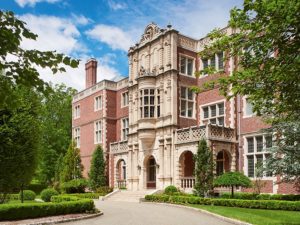
Darlington’s dramatic façade (and banner) was inspired by the Jacobean design of Bramshill House in Hampshire, England. Photographs: Laura Moss
Finished in 1907, and built of Harvard brick and Indiana limestone—a huge H shape flanked by pergolas—Darlington was indeed palatial, unlike anything that had gone before. Styled with acute attention to detail, standout features included a two-story inglenook in the great hall, and a library roof painted by Tiffany Studios’ James Wall Finn, whose other creations include a mural at the New York Public Library, depicting billowy clouds.
Set in the Ramapo Valley in Mahwah, New Jersey, a mere 25 miles to Manhattan, Darlington wore the look and carried the gravitas of a centuries-old build. Yet with such features as steam heating, integrated intercom systems, and elevators, it was way ahead of its time, prompting The New York Times to describe it as “the most modern home in the US.” In 1912, The Architectural Record praised its “effective merging of the arts in its decoration, the adoption of Old World conceits to New World conditions—the luxury of modern living.”
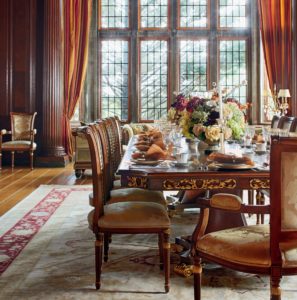
The formal dining room in Darlington’s south wing, with its spectacular carved wooden ceiling. Photograph: Laura Moss
A century and a seven-year renovation later, thanks to Ilija Pavlovic, president and CEO of Special Properties Real Estate Services LLC, the exclusive affiliate of Christie’s International Real Estate in the region, Darlington can again command such lofty headlines. ‘‘When I bought it, there were three things I could do: preserve it as a museum; protect the site and let it age naturally; or bring it back to life,” says Pavlovic, who acquired the property in 2008. “My aim was to preserve the original beauty, but also bring it up to date and make it a home for the 21st century.”
Pavlovic’s restoration of Darlington has been to reflect the Crockers’ original scenario: to have a one-of-a-kind home, beautiful to look at and finished to the highest standards, with all the trimmings for modern life. To achieve it was a case of history repeating itself.
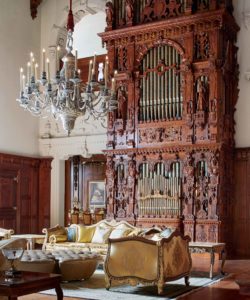
Fitted with silver Tiffany chandeliers and intricate details in rich, dark woods, the dramatic great hall also has a fully restored Aeolian player pipe organ. Photograph: Laura Moss
“We stripped back the floors and walls to the original and rebuilt with a forensic-style attention, using the same materials. Marble and wood—American white oak, English oak, cherry, Circassian walnut, English walnut, and Californian redwood—some of which were unique in the US when first used. We also used 200 slabs of onyx, all cut to measure,” Pavlovic says. “All 18 stone fireplaces were refurbished and each of the 476 windows was replaced and approved by the state historic preservation office, and all mechanical systems—the original Aeolian player pipe organ included—were renewed.”
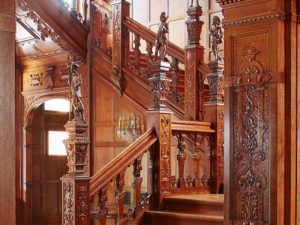
Elizabethan design influences the grand stairway, paneled in oak. Photograph: Laura Moss
During the original building of Darlington, artisans from around the globe were employed; similarly, when work began on restoring it, tradesmen were recruited worldwide. “We had up to 200 people on site, all speaking different languages but working together to revive a masterpiece. We worked with several groups and designers, not copying what had gone before, but always [applying] the same level of craftsmanship to match the original.”
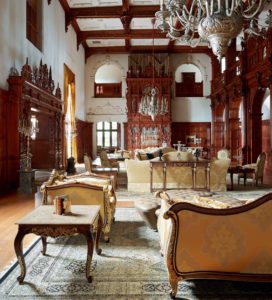
Meticulously restored to its original grandeur, Darlington also incorporates every update for modern life, including a wine cellar, cigar room, game and poker rooms, a cinema room, spa, sauna, lap pool, gym, and beauty room.
Bespoke furniture on the first floor was designed by Francesco Molon, whose design résumé includes presidential palaces, The Ritz-Carlton New York, and The Savoy, London. It was crafted to match and echo the original wood-carved ceilings, walls, stairways, and arches—all the work of master wood carver John H Elliott.
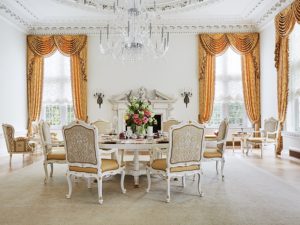
In contrast to the carved brown wood seen elsewhere in the home, the tearoom is a tranquil sea of white. Photograph: Laura Moss
Listed with the National Register of Historic Places, today’s 58-room Darlington stands four floors high and measures 50,000 square feet. It has 21 bedrooms, 29 bathrooms—just the two in the guest master suite are the same—a breakfast room, dining room, and afternoon tearoom. The original kitchen has had a makeover, but Darlington also features a new restaurant-style kitchen equipped to serve 250 meals at a time. And leisure now features prominently, with new additions. There are game and poker rooms, a cinema room, a cigar room and wine cellar, and a spa, sauna, lap pool, gym, and beauty room.
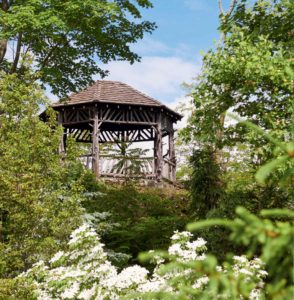
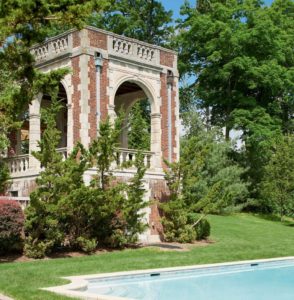
Darlington’s bucolic grounds include an outdoor swimming pool with a cabana, a pro-standard tennis court, and pergolas and terraces for relaxing and entertaining.
It may have all the amenities of a five-star hotel, but, says Pavlovic, “It’s very important Darlington is seen as a home.” Indeed, step outside and Darlington has the feel of a veritable country estate. Anchored in 12 acres with the Ramapo River running close by it feels private and positively bucolic, surrounded by manicured lawns and rare species of trees, some more than 200 years old. For the active there is a swimming pool with cabana, as well as a pro-standard tennis court, laid with the same surface as Flushing Meadows’s Arthur Ashe Stadium. For less strenuous pursuits, there are terraces on which to relax and sip a cocktail, and pergolas for entertaining.
Pavlovic has done a remarkable job on Darlington. With patience, knowledge, foresight, and an obvious love of great artisanship, he has woven the historic with the contemporary and married two centuries to create a harmonious, unique home. Wonderfully nostalgic, thoroughly modern, and a half-hour drive to the Big Apple, it offers both a talk-of-the-town and country-retreat experience.
Please click here to view original post.
